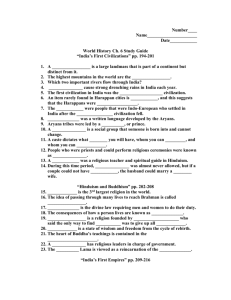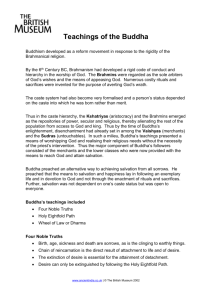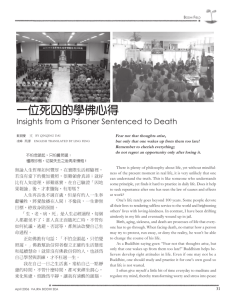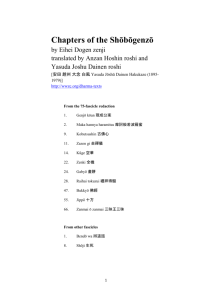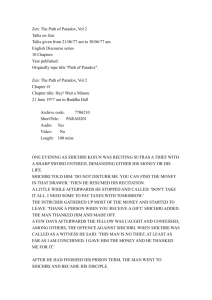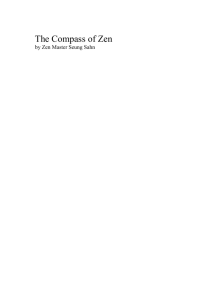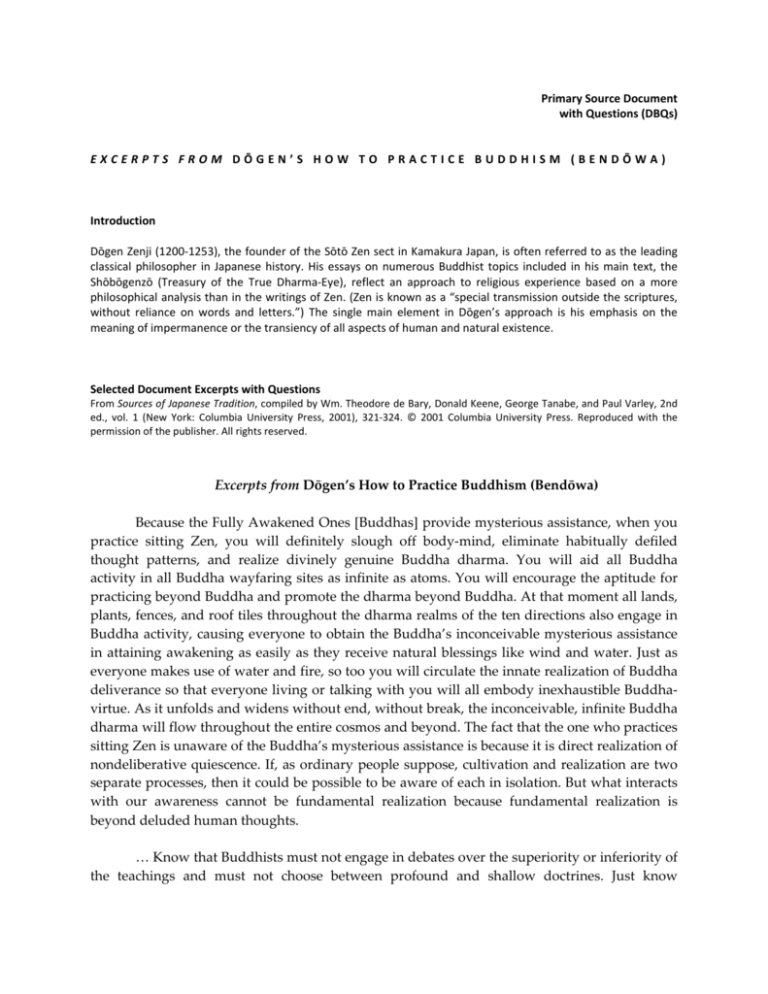
Primary
Source
Document
with
Questions
(DBQs)
EXCERPTS
FROM
DŌGEN’S
HOW
TO
PRACTICE
BUDDHISM
(BENDŌWA)
Introduction
Dōgen
Zenji
(1200‐1253),
the
founder
of
the
Sōtō
Zen
sect
in
Kamakura
Japan,
is
often
referred
to
as
the
leading
classical
philosopher
in
Japanese
history.
His
essays
on
numerous
Buddhist
topics
included
in
his
main
text,
the
Shōbōgenzō
(Treasury
of
the
True
Dharma‐Eye),
reflect
an
approach
to
religious
experience
based
on
a
more
philosophical
analysis
than
in
the
writings
of
Zen.
(Zen
is
known
as
a
“special
transmission
outside
the
scriptures,
without
reliance
on
words
and
letters.”)
The
single
main
element
in
Dōgen’s
approach
is
his
emphasis
on
the
meaning
of
impermanence
or
the
transiency
of
all
aspects
of
human
and
natural
existence.
Selected
Document
Excerpts
with
Questions
From
Sources
of
Japanese
Tradition,
compiled
by
Wm.
Theodore
de
Bary,
Donald
Keene,
George
Tanabe,
and
Paul
Varley,
2nd
ed.,
vol.
1
(New
York:
Columbia
University
Press,
2001),
321‐324.
©
2001
Columbia
University
Press.
Reproduced
with
the
permission
of
the
publisher.
All
rights
reserved.
Excerpts
from
Dōgen’s
How
to
Practice
Buddhism
(Bendōwa)
Because
the
Fully
Awakened
Ones
[Buddhas]
provide
mysterious
assistance,
when
you
practice
sitting
Zen,
you
will
definitely
slough
off
body‑mind,
eliminate
habitually
defiled
thought
patterns,
and
realize
divinely
genuine
Buddha
dharma.
You
will
aid
all
Buddha
activity
in
all
Buddha
wayfaring
sites
as
infinite
as
atoms.
You
will
encourage
the
aptitude
for
practicing
beyond
Buddha
and
promote
the
dharma
beyond
Buddha.
At
that
moment
all
lands,
plants,
fences,
and
roof
tiles
throughout
the
dharma
realms
of
the
ten
directions
also
engage
in
Buddha
activity,
causing
everyone
to
obtain
the
Buddha’s
inconceivable
mysterious
assistance
in
attaining
awakening
as
easily
as
they
receive
natural
blessings
like
wind
and
water.
Just
as
everyone
makes
use
of
water
and
fire,
so
too
you
will
circulate
the
innate
realization
of
Buddha
deliverance
so
that
everyone
living
or
talking
with
you
will
all
embody
inexhaustible
Buddha‑
virtue.
As
it
unfolds
and
widens
without
end,
without
break,
the
inconceivable,
infinite
Buddha
dharma
will
flow
throughout
the
entire
cosmos
and
beyond.
The
fact
that
the
one
who
practices
sitting
Zen
is
unaware
of
the
Buddha’s
mysterious
assistance
is
because
it
is
direct
realization
of
nondeliberative
quiescence.
If,
as
ordinary
people
suppose,
cultivation
and
realization
are
two
separate
processes,
then
it
could
be
possible
to
be
aware
of
each
in
isolation.
But
what
interacts
with
our
awareness
cannot
be
fundamental
realization
because
fundamental
realization
is
beyond
deluded
human
thoughts.
…
Know
that
Buddhists
must
not
engage
in
debates
over
the
superiority
or
inferiority
of
the
teachings
and
must
not
choose
between
profound
and
shallow
doctrines.
Just
know
Primary
Source
Document
with
Questions
(DBQs)
on
EXCERPTS
FROM
DŌGEN’S
HOW
TO
PRACTICE
BUDDHISM
(BENDŌWA)
whether
the
practice
is
authentic
or
not.
Grass,
flowers,
the
landscape
itself,
have
brought
some
people
into
the
Buddha
Way.
Merely
grasping
earth
or
sand
has
caused
others
to
receive
and
preserve
the
Buddha‑mind
Seal.
This
means
that
the
greatest
words
are
the
ones
whose
abundant
meanings
overflow
from
every
existing
thing.
The
Great
Dharma
Wheel
of
preaching
turns
in
every
speck
of
dust.
In
light
of
this,
a
phrase
like
“this
very
mind
is
Buddha”
is
just
the
moon
reflected
in
water.
“This
very
sitting
becomes
Buddha”
is
just
a
reflection
in
a
mirror.
Do
not
be
misled
by
clever
slogans.
I
now
recommend
the
practice
of
direct
realization
of
bodhi
because
I
teach
the
marvelous
Way
directly
transmitted
by
the
Buddhas
and
Zen
ancestors
and
because
I
want
you
to
become
a
true
man
of
the
Way.
[Nishio,
Shōbōgenzō,
vol.
1,
pp.
101–102;
WB]
Questions:
1.
What
are
the
benefits
of
the
practice
of
sitting
Zen?
2.
What
does
the
infinite
“Buddha
dharma”
refer
to?
3.
What
does
Dōgen
mean
by
avoiding
clever
slogans?
4.
What
could
“merely
grasping
earth
or
sand”
be
a
metaphor
for?
Asia
for
Educators
l
Columbia
University
l
http://afe.easia.columbia.edu
Page
2
of
2





